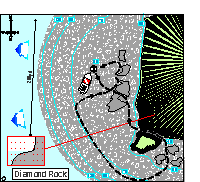15'-140'

This craggy multi-faceted protrusion not only looks like a diamond but was once the jewel in the crown of the British fleet of war ships attempting to dominate the Caribbean islands. The British and the French fought over so many islands in the early 19th century that ships were sometimes in short supply. Only one ship, the 74-gun Centaur was assigned to blockade the ports of Martinique. By capturing a French ship they were able to double their defences but even this was poor cover because Martinique had two harbours, St. Pierre in the north and the bay which is now called Fort de France in the south.
Short of ships but not imagination, Commodore Sir Samuel Hood declared Diamond Rock a man-of-war and proceeded to equip her as one. Guns were hauled to the top of the rock and the passage between Martinique and Diamond Rock was secured. They even built a hospital in one of the caves on the rock. This was no temporary gesture; the rock remained in service for 2 years.
Thankfully, scuba equipment had not been invented or no doubt someone would have decided that the easiest way of unseating the British would be to send a crack team of navy divers to plant explosives under the rock. Though, the underwater terrain suggests that someone might have tried.
Click on image for larger map
When we arrive at the rock our dive leader decides to do the site known as La Faille, meaning a fault or breach in the rock. We anchor on the west side of the island, protected from the easterly wind and waves. The boats are able to anchor here on sand in 65 feet, on the top of a ledge. As we drop down the anchor line, we can see the edge of the ledge as it drops away steeply and are tempted to explore. But, we had been briefed that a tunnel was fun to swim through so we follow our dive leader as he moves off anti-clockwise.
On the sand and the rocks a healthy crop of sargassum is growing but it soon clears and the scenery changes to a rainbow of sponges and coral. Lively shining crinoids wave their long arms medusa-like. Towering clumps of encrusted rocks sprout anemones and a variety of hydroids. There are numerous trumpetfish well disguised by the sargassum.
A curtain of sea fans draws us through a small tunnel where yet more crinoids hang from the walls and ceilings, filtering the water that passes through and stroking the divers like the outstretched arms of fans eager for contact with their idol. As we emerge from the tunnel a decorative display of hard corals greets us.
Thinking we had seen the tunnel mentioned in our briefing, we are unprepared for the arch ahead which, as we enter, opens up into a tunnel right under the rock. The noise is extraordinary as the sea forces itself through the tunnel, tugging at the very foundations of the rock. The surge lifts and discards us as if we are feathers or at least inconsequential compared to its battle with the cold hard material of Diamond Rock.
As we reluctantly leave the tunnel behind, we are greeted by sunny yellow tube sponges and a whole rock covered in mat gorgonians like a shag pile carpet. Turn around and look back at the tunnel and you will see a rock formation like the bowsprit of a ship, perhaps the rock's attempt to modify its morphology to fit its historical role.
After the tunnel, we turn right and return along a slope toward the anchored boat. There are good brain and flower corals here and elephant ear sponges like huge pieces of discarded orange peel. We see several sargassum triggerfish along this stretch of the slope. It is interesting terrain from 50 feet down to as deep as your dive profile and air will allow. Sergeant majors and damselfish will chase you off their patch and look out for spotted drums under the numerous ledges.
Back on the boat we gaze up at the rock, imagining the colourful life it had for a short spell in the early 1800s. It seems strange to think of the colourful life below the waterline going on then as it does now.
There are a number of different sites around Diamond Rock. One known as La Piscine is relatively shallow (15-25 feet) and suitable for novice divers. At one site there is an old French warship anchor at 35 feet. On the west side an English warship anchor has been found but, unfortunately, it is at 200 feet. Although the rock is on the south side of the island, hence exposed to the open sea, the dive stores are usually able to find a sheltered area for divers to kit up and the area can be dived almost everyday.
Thanks to Philip Callewaert of Subchandlers.
